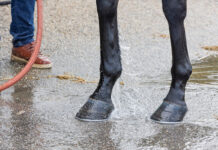

Q: I have a young horse that had a locked stifle. It happened twice so far, once when she was 2 years old and the second time was about a year after that. Why does it happen? Is there a treatment for it? And is it a long term problem?
A: Anatomy wasn’t my best subject in vet school, but I do remember that the equine stifle is the equivalent of the human knee, complete with patella or kneecap. What’s unique about the horse is the presence of three patellar ligaments (lateral, middle, and medial) that hook over a notch or ridge at the end of the femur bone, allowing the horse to “lock” its hind legs and therefore sleep standing up (“doze” would be the more accurate term, as deep, REM-quality sleep in the horse can only be obtained when lying down).
A locked stifle, also known as intermittent upward fixation of the patella, occurs when this hooking mechanism doesn’t unhook properly, causing the horse’s hind leg to be stuck in the extended position momentarily or for longer periods of time. Signs of a locked stifle include:
- Anything from a slight delay or alteration of the flight pattern of a hind limb to a completely straight limb that “knuckles over” at the ankle or fetlock and drags the toe
- Difficulty walking up and down hills
- Trouble backing
- Resistance and problems in the canter (especially the trot to canter transition)
- Worsening with rest
- No improvement with NSAIDs such as bute
Because some of these signs overlap with other conditions of the hind legs such as shivers, stringhalt, fibrotic myopathy, PSSM, and tying up, it is important for your veterinarian to examine your horse and confirm a diagnosis of an upwardly fixated of the patella as the problem. Showing your vet pictures or a video may be helpful since the condition comes and goes and may not occur during a short farm visit.
There are generally considered to be four main reasons for a stifle to lock:
- Lack of muscular fitness
- Poor body condition (ie debilitation, weight loss)
- Trauma or injury to the area
- Conformation issues of the entire limb, within the stifle joint itself, or of the hoof
It is not uncommon to see locked stifles in young horses such as yours that haven’t yet fully filled out or developed, or who aren’t yet in a regular exercise program. It can also occur when a horse is taken abruptly out of training and confined to a stall, causing muscle loss. Similarly, horses that are underweight or weak can also be prone to a “sticky” patella, as can those that have had direct trauma to the tissues and structures of the stifle. Finally, it is believed that horses with very straight-legged hind leg conformation when viewed from the side, horses with lax patellar ligaments, or horses with incorrect angles within the hind feet are prone to locking stifles.
This condition may be self-correcting in your filly as she matures. That is, she may “grow out of” her sticky stifles as she gains height, weight, and muscle mass. Regular turnout and controlled exercise are highly recommended – your vet may even suggest a program that involves therapeutic ground work, cavaletti, hill work, backing, transitions, and other movements specifically designed to target the muscles, tendons, and ligaments of the hindquarters. Corrective trimming and/or shoeing may be necessary, and the footing of turnout and work areas should undergo careful consideration. For horses that do not respond to these conservative approaches, hormonal (estrogen) therapy, injecting a local counterirritant or “blister,” and even surgery are additional options that can be discussed with your vet.






